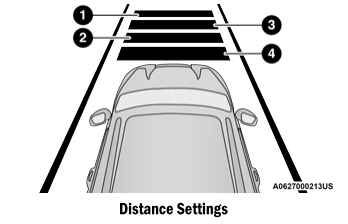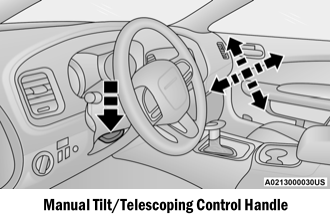Dodge Charger: CRUISE CONTROL SYSTEMS — IF EQUIPPED / Setting The Following Distance In ACC, Overtake Aid
Setting The Following Distance In ACC
The specified following distance for ACC can be set by varying the distance setting between four bars (longest), three bars (long), two bars (medium) and one bar (short). Using this distance setting and the vehicle speed, ACC calculates and sets the distance to the vehicle ahead. This distance setting appears in the instrument cluster display.

- Longest Distance Setting (Four Bars)
- Medium Distance Setting (Two Bars)
- Long Distance Setting (Three Bars)
- Short Distance Setting (One Bar)
To increase the distance setting, push the Distance Setting Increase button and release. Each time the button is pushed, the distance setting increases by one bar (longer).
To decrease the distance setting, push the Distance Setting Decrease button and release.
Each time the button is pushed, the distance setting decreases by one bar (shorter).
If there is no vehicle ahead, the vehicle will maintain the set speed. If a slower moving vehicle is detected in the same lane, the instrument cluster display will show the ACC Set With Target Detected Indicator Light, and the system will adjust the vehicle speed automatically to maintain the distance setting, regardless of the set speed.
The vehicle will then maintain the set distance until:
- The vehicle ahead accelerates to a speed above the set speed.
- The vehicle ahead moves out of your lane or view of the sensor.
- The distance setting is changed.
- The system disengages.
The maximum braking applied by ACC is limited; however, the driver can always apply the brakes manually, if necessary.
NOTE:
The brake lights will illuminate whenever the ACC system applies the brakes.
A Proximity Warning will alert the driver if ACC predicts that its maximum braking level is not sufficient to maintain the set distance. If this occurs, a visual alert “BRAKE” will flash in the instrument cluster display and a chime will sound while ACC continues to apply its maximum braking capacity.
NOTE:
The “BRAKE!” screen in the instrument cluster display is a warning for the driver to take action and does not necessarily mean that the Forward Collision Warning system is applying the brakes autonomously.
Overtake Aid
When driving with Adaptive Cruise Control (ACC) engaged and following a vehicle, the system will provide an additional acceleration up to the ACC set speed to assist in passing the vehicle. This additional acceleration is triggered when the driver utilizes the left turn signal and will only be active when passing on the left hand side.
 To Vary The Speed Setting
To Vary The Speed Setting
To Increase Or Decrease The Set Speed
After setting a speed, you can increase the set speed by pushing the SET (+)
button, or decrease speed by pushing the SET (-) button...
 ACC Operation At Stop
ACC Operation At Stop
In the event that the ACC system brings your vehicle to a standstill while following
the vehicle in front, if the vehicle in front starts moving within two seconds of
your vehicle coming to a standstill, your vehicle will resume motion without the
need for any driver action...
Other information:
Dodge Charger 2011-2025 Owner's Manual: Tread Wear Indicators
Tread wear indicators are in the original equipment tires to help you in determining when your tires should be replaced. Worn Tire New Tire These indicators are molded into the bottom of the tread grooves. They will appear as bands when the tread depth becomes a 1/16 of an inch (1...
Dodge Charger 2011-2025 Owner's Manual: PUBLICATION ORDER FORMS
To order the following manuals, you may use either the website or the phone numbers listed below. Service Manuals These comprehensive Service Manuals provide a complete working knowledge of the vehicle, system, and/or components and is written in straightforward language with illustrations, diagrams, and charts...
Categories
- Manuals Home
- Dodge Charger Owners Manual
- Dodge Charger Service Manual
- Power Adjustment (Front Seats) — If Equipped
- Opening And Closing The Trunk
- WHEEL AND TIRE TORQUE SPECIFICATIONS
- New on site
- Most important about car
Manual Tilt/Telescoping Steering Column — If Equipped
This feature allows you to tilt the steering column upward or downward. It also allows you to lengthen or shorten the steering column. The tilt/telescoping control is located below the steering wheel at the end of the steering column.

